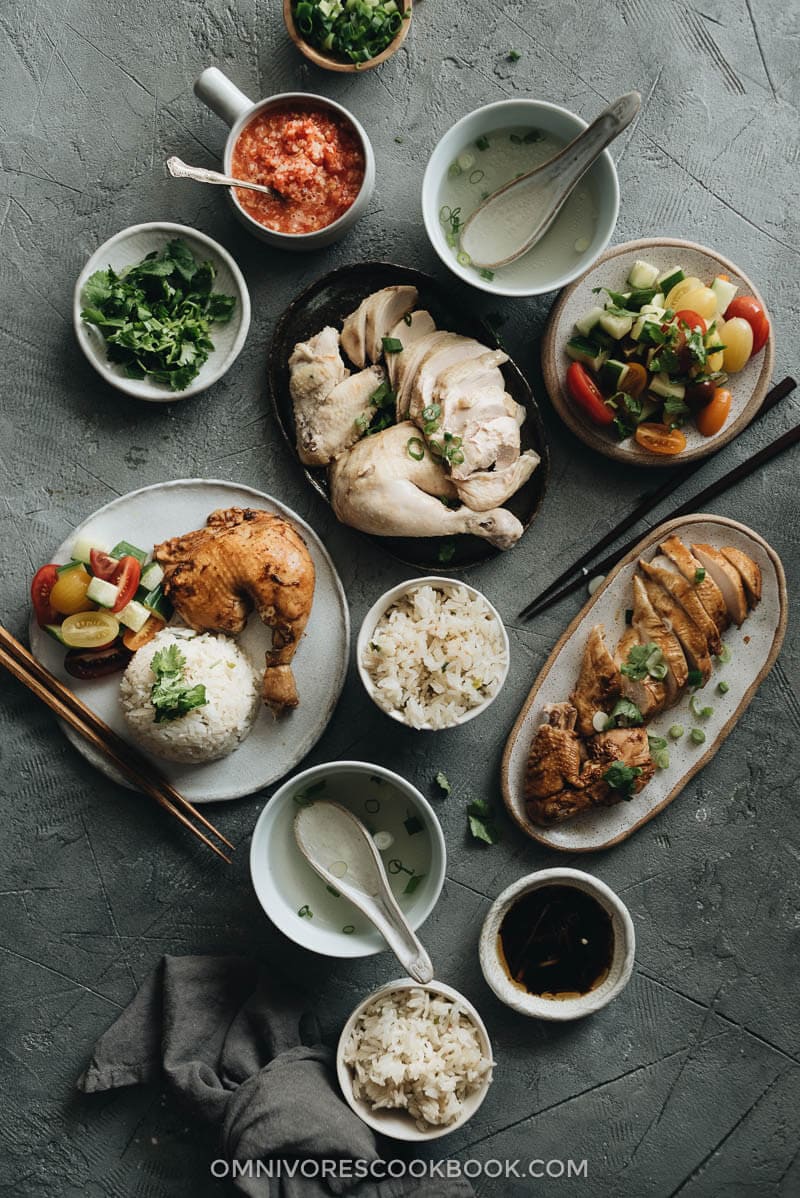
According to Wikipedia, Hainanese chicken rice originated in Hainan, but then grew so popular in Singapore that it became one of their national dishes. Growing up in northern China, I’d never heard of or tried this dish until I moved to Japan in college. It was interesting to learn a bit more about my own culture when living in a foreign country. Although I never tried the dish after seeing the picture of it – boiled chicken on white rice? Huh, it seemed kinda lame…
The first time I tried Hainanese chicken rice was when I was on a business trip to Singapore. It BLEW MY MIND. A local colleague took me to a hawker center and we ordered the dish. It was totally the opposite of my first impression of the dish. The chicken was juicy and tender, and was so refreshing and delicious paired with the dipping sauce. The rice was definitely the best part. It was cooked in chicken fat and chicken broth, with plenty of ginger and garlic. It was so rich and bursting with flavor. I almost licked my plate clean after eating a big serving, craving for more afterwards.
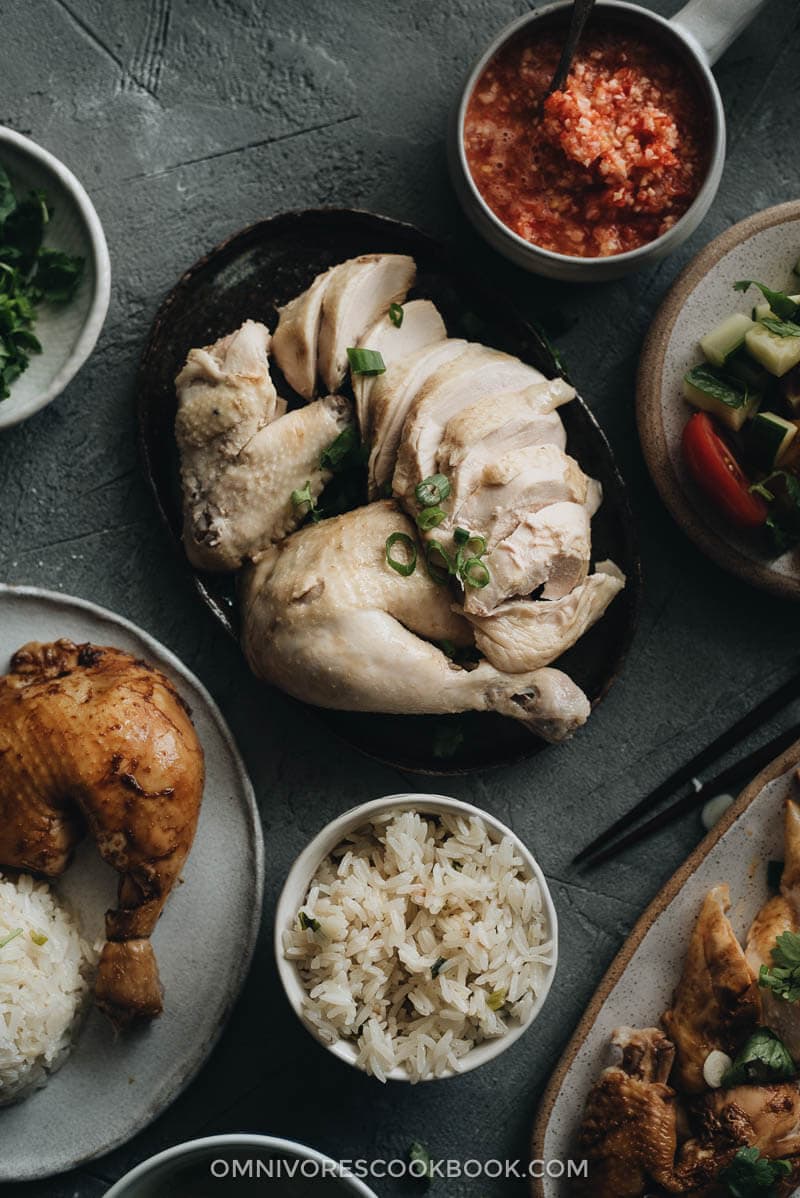
Now that I’m living in the US, it’s quite hard to find a properly done Hainanese chicken rice in a restaurant. So I have to head to my own kitchen when I need a fix. This dish definitely doesn’t belong in the “Weeknight Dinner” genre. It’s more of a weekend project dish. The recipe might look very long, but believe me, it’s really straightforward and not as complicated as it seems.
One dish, two versions
When I had my first Hainanese chicken rice in Singapore, my colleague ordered two types of chicken for me to try. He told me that even although the mainstream one is the white chicken, the soy sauce version is actually more popular and tastier. He was not lying!
Making the soy sauce version is extremely easy. You simply need to brush a few layers of sweet soy sauce on the chicken once you’re done boiling it and letting it air dry. Then you’ll have a chicken that’s more flavorful without covering up the original taste.
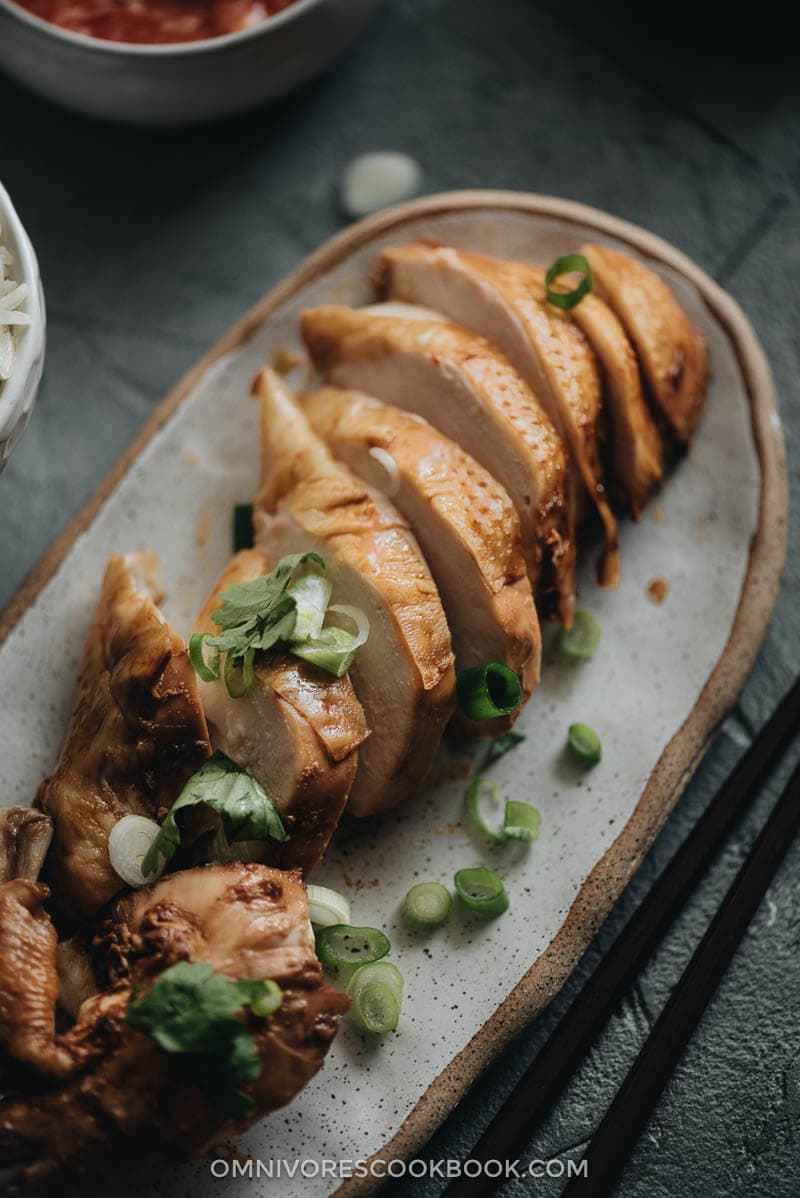
I used my homemade sweet soy sauce because I always keep a jar of it in my fridge. I made it with braising ingredients, so it has a more complex taste than the store-bought version. Of course, you can use a bottled sweet soy sauce as well.
You can also make the original version by brushing some sesame oil on the chicken and skipping the soy sauce.
For those who do not like boiled chicken skin, here is a quick way to make the dish taste even better:
Sprinkle a bit of salt onto the chicken skin and grill the chicken skin-side-down on a lightly oiled frying pan. Now you have a perfectly cooked juicy chicken with crispy skin. Isn’t that wonderful?
Cooking notes
1. What type of chicken to use
The rule of thumb is, the smaller the chicken, the better. I used a 2.6-lb chicken in my recipe.
In fact, an authentic Chinese recipe would ask you to find an organic free-range heritage chicken. The recipe uses very minimal seasoning to bring out the natural essence of the chicken, which requires a bird with a smaller body to absorb the seasoning and taste great by itself. But I found that a small-ish chicken that I purchased from Central Market came out really great.
If you can not find a smaller chicken, a normal-sized one will work just as well. But you will need to increase the cooking time depending on the size of the chicken. A four-pound chicken will take about 45 minutes to simmer, and a five-pound one about an hour.
2. Not overcooking is the key
You want to cook until the chicken just cooked through, so you’ll have super tender and juicy meat that has a nice aroma. Overcooking will end up with dry, tough chicken meat that’s not delicious at all. You can use a thermometer to test the chicken and monitor it closely. But I found that the easiest way is to insert a small paring knife into the joint between the thigh and body. Lightly slice the skin and push the thigh away from the body. If the juice is clear and the meat white, the chicken is fully cooked.
Once you cook the chicken, immediately immerse it in an ice bath so the chicken won’t continue to be cooked by the residual heat.
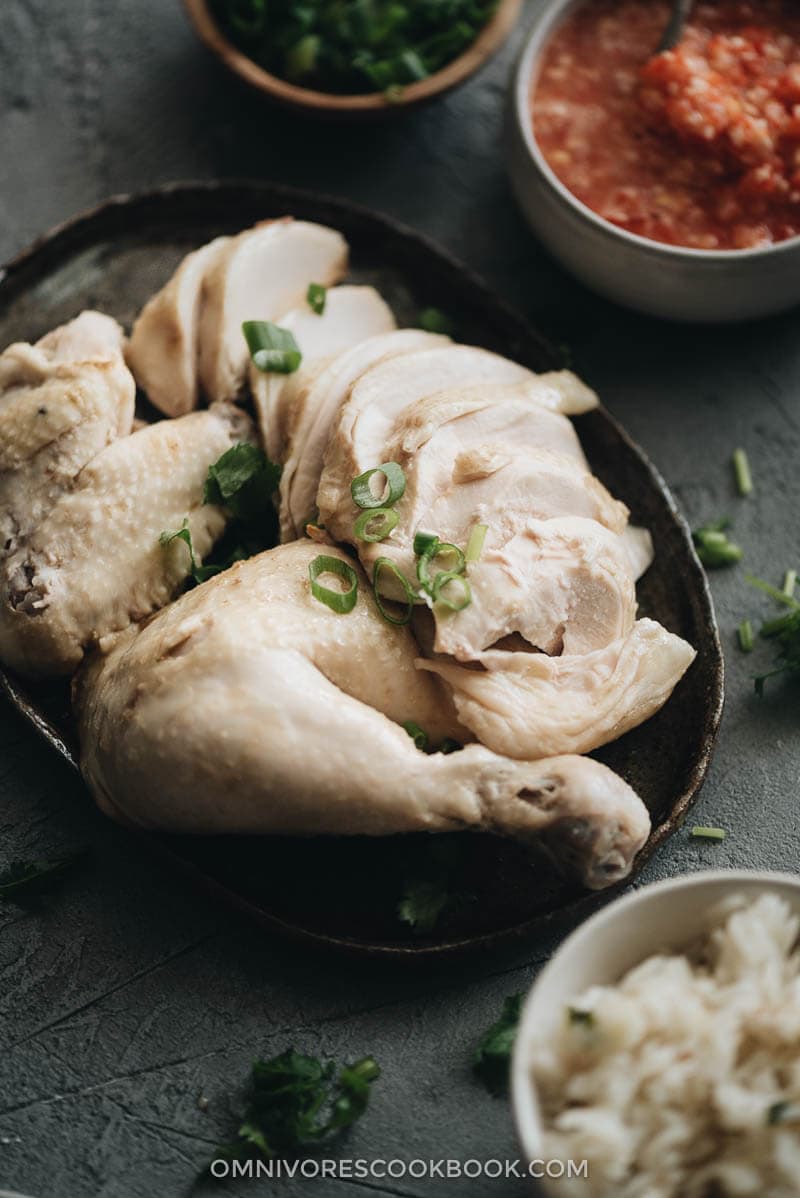
3. How to use chicken parts instead of a whole chicken
I always highly recommend using a whole chicken to cook this dish, because you will end up with juicier, more flavorful meat.
However, it’s possible to use chicken parts such as breasts and legs, as well.
The cooking time is largely based on the size of the chicken and the quantity of pieces, but here are some general guidelines:
- Boneless skinless breast – 15 to 20 minutes
- Bone-in skin-on breast – 20 to 30 minutes
- Boneless skinless thigh – 15 to 20 minutes
- Bone-in skin-on thigh – 20 to 30 minutes
When you use chicken parts, cook them in a smaller pot and add just enough water to cover. Cook uncovered, bringing the water to a simmer (not a boil), and let it simmer until just cooked through. The chicken will turn out just as tender.
Note, when using chicken parts, you might not get enough chicken broth to serve as chicken soup on the side.
4. Dipping sauce
The most authentic sauce is the chili dipping sauce, but I’ve included a ginger soy sauce, as well. The ginger soy sauce is a family recipe and we use it with almost everything. If you don’t feel like making a sauce, you can serve the chicken with Sriracha, as well.
5. How to make extra fragrant rice
The rice is my favorite part of this recipe because it is so so fragrant. To make the best rice, make sure you use plenty of fresh ginger, garlic, and green onion. Authentic Hainanese chicken rice uses rendered chicken fat in the rice. If you’re not comfortable with that, or if your chicken is too lean, you can use butter instead. When you saute the rice with the aromatics, your house will smell heavenly 🙂

A final thought
I would highly recommend you make the Hainanese chicken rice in advance. Especially if you’re making the sweet soy sauce version. If you apply the sauce 2 to 3 times and let it dry, the sauce will infuse into the chicken and make it so much more flavorful. The chicken tastes great cold or hot. If you make everything ahead of time, you can simply heat up the rice, soup, and chicken. Serve it with a simple cucumber salad, and you’ll have a delicious and healthy meal that tastes even better than the restaurant version!
More real-deal Chinese recipes
- How to Make Shumai
- Chicken Wonton Soup
- Steamed Ribs in Black Bean Sauce (豉汁蒸排骨)
- Real-Deal Sichuan Chicken in Red Oil Sauce (口水鸡, Saliva Chicken)
- Mom’s Best Pork Dumplings with Cabbage
If you give this recipe a try, let us know! Leave a comment, rate it (once you’ve tried it), and take a picture and tag it @omnivorescookbook on Instagram! I’d love to see what you come up with.
Chinese Cooking Made Easy
Are you new to this website? This free email series is a great place to start. I’ll walk you through a few of my most popular recipes and show you how and why they work. You’ll quickly start to cook better Chinese food in your own kitchen.
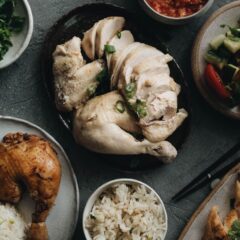
Hainanese Chicken Rice (海南鸡饭)
Ingredients
Chicken
- 2.5 to 3 lbs (1.1 to 1.4 kg) whole chicken (*Footnote 1)
- 1 thumb ginger , sliced
- 3 green onions , cut into 6 cm (2.5 inch) long pieces
- 1 tablespoon sea salt
- 1 tablespoon sesame oil
- 2 tablespoons homemade sweet soy sauce (or store-bought type) (Optional)
- chopped cilantro for garnish (Optional)
Rice
- 2 tablespoons butter and/or chicken fat from the chicken
- 3 green onions , chopped
- 1 tablespoon minced ginger
- 3 cloves garlic , minced
- 2 cups (480 ml / 16 oz) jasmine rice, rinsed and drained
- 3 cups chicken broth from boiling the chicken
Chili dipping sauce (Or Sriracha Sauce)
- 3 fresh Thai chili peppers , chopped (seed the peppers for a less spicy sauce)
- 1/4 red bell pepper , seeded and chopped
- 1/4 small white onion , chopped
- 2 tablespoons minced ginger
- 2 cloves garlic , chopped
- 1/2 teaspoon salt
- 1/3 cup lime juice or lemon juice
(Optional) Ginger soy dipping sauce (*Footnote 2)
- 1 tablespoon light soy sauce
- 1 tablespoon Chinkiang vinegar
- 1 tablespoon thinly sliced ginger
- 1 teaspoon sugar
- 1 teaspoon sesame oil
Instructions
Chicken
- Remove the neck and innards from the chicken cavity and either reserve them for making stock or gravy or discard them. Remove the chicken fat from the cavity and set it aside for making the rice.
- Place the whole chicken breast-side-up in a 5-quart pot or one that’s deep and wide enough to hold the chicken. Add water until it covers the chicken (about 8 cups of water in my case). Bring the water to a boil over medium-high heat. Gently move the chicken with a spatula so it does not stick to the bottom. Skim the foam with a fine mesh strainer until the soup becomes clear, 5 minutes or so.
- Turn to medium-low heat. Add the ginger, green onion, and salt. Carefully flip the chicken using a spatula and a pair of tongs. Simmer for 10 minutes. Flip the chicken again so the breast side is up. Continue to simmer until the chicken is just cooked through, 15 to 20 minutes, depending on the size of your chicken. Test the doneness by poking the joint between the thigh and the body with a paring knife. The chicken is cooked if the juice comes out clear. Or you can use a thermometer inserted into the same joint. It should register 165 degrees F (74 C).
- Prepare a large ice bath when the chicken is almost done.
- When the chicken is done, immediately remove it from the pot and plunge it into the ice bath to cool. This process will tighten the chicken skin and stop the cooking process to keep the meat tender. Once the chicken is mostly cooled, 3 to 4 minutes, drain and pat it dry with paper towels. Transfer to a cutting board to air dry.
- Strain and save the chicken broth for cooking the rice and making chicken soup.
Rice
- While the chicken is cooling, prepare the rice. Heat the reserved chicken fat in a non-stick skillet over medium heat. Cook and stir occasionally, until the oil renders. You should have about 2 tablespoons of oil in your pan. If there isn’t enough chicken fat, add some butter to the pan (I used 1 tablespoon of butter).
- Add the ginger, garlic, and green onion to the skillet. Cook and stir until fragrant, 1 minute or so. Add the rice and continue stirring until the rice turns pale yellow, 3 to 4 minutes. Turn to medium-low heat. Transfer 3 cups of chicken broth from the big pot you used to cook the chicken to the rice skillet. Cook, covered, for 12 minutes. Then remove the pan from the stove. Let rest, covered for another 10 minutes. Fluff the rice with a spatula. Taste the rice. Add a bit more salt, if needed, and mix well.
Sauce
- While cooking the rice, prepare the chicken and the sauce(s). Separate the chicken into legs, breasts, and wings.
- Prepare chili dipping sauce: add all the ingredients into a mini-food processor or the chopping container included with your immersion blender. Chop everything into a coarse paste.
Serving
- There are two ways to prepare the chicken for serving. You can rub either sesame oil or sweet soy sauce onto the skin. Read more about the two options in the blog post above. Once done, slice the chicken breast into bite-sized pieces. Transfer to a big plate and garnish with cilantro, if using.
- Before you serve, you may want to reheat the chicken broth. Garnish the hot soup with cilantro and green onion. Serve the soup with the rice and chicken. Enjoy!
Notes
- You can use a larger chicken or chicken parts such as breasts or thighs. Read the blog post on this topic to determine the cooking time needed.
- The chili sauce is the most authentic sauce to serve with the dish. The gingery sauce is a family favorite so I’ve added it here. You can also serve the chicken with Sriracha sauce.
Nutrition
Have a question or feedback? Add a Comment
Did you make this? I want to see! Tag @OmnivoresCookbook on Instagram, and rate the recipe below.
The recipe was published on Jan 21, 2014 and updated by Jun 22, 2018.

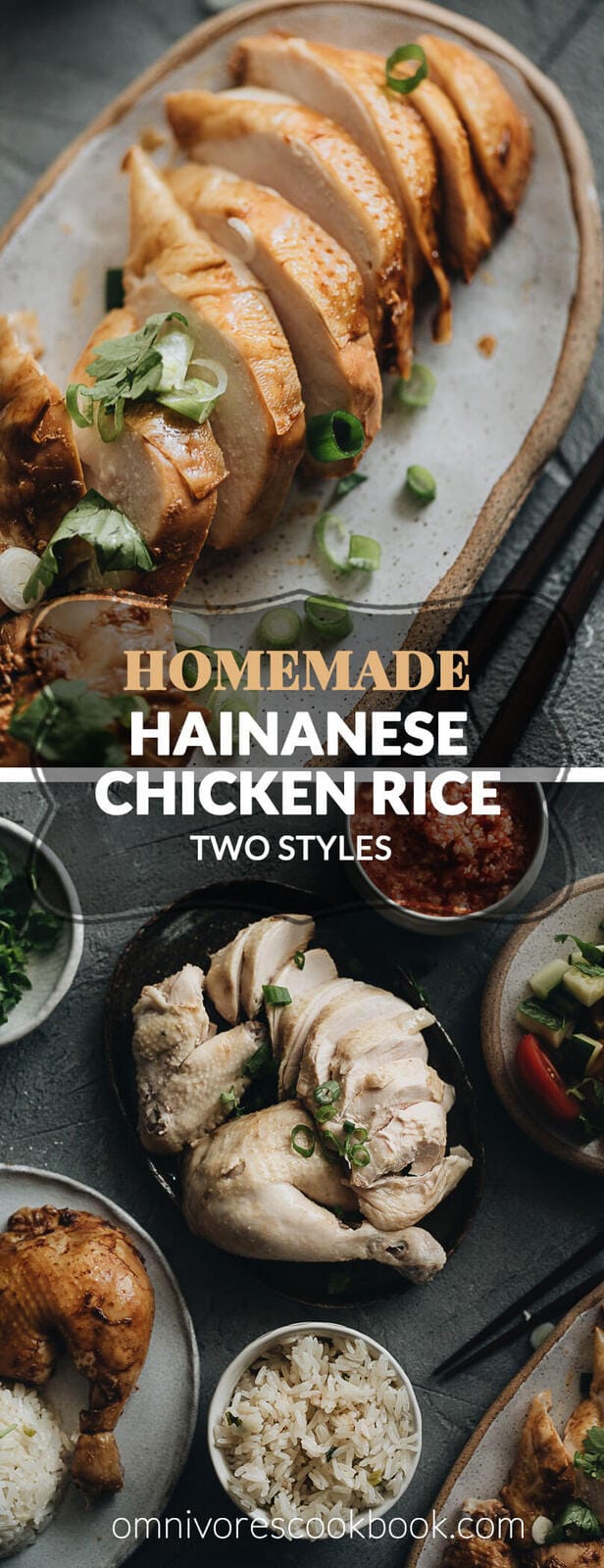


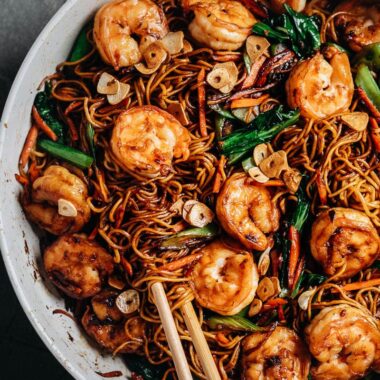
Hannah
Thanks for the recipe! I am curious about grilling the skin to crisp it instead of boiling it. I thought about this as well since I prefer crispy chicken skin but then realized it wouldn’t produce broth for cooking the rice. If grilling the chicken, would you just cook your rice with water or store bought broth?
Maggie Zhu
I would cook the rice with store bought broth. It also helps a lot to add some chicken fat into the rice: trim off a bit chicken fat, slowly cook the fat in a pan to render some oil, and put the rendered oil into the rice. The chicken fat adds a ton of flavor.
If you did end up poaching the chicken, you can also dust the cooked chicken with some cornstarch and pan fry it. It’s one of my favorite ways to get crispy chicken (usually the leftover pieces when I used to make chicken broth).
Suzette
This is now a family davorite
Joanne C
I tried this last night with bone-in, skin-on thighs and other than my chicken taking a little longer to completely cook through, it was AMAZING. I didn’t need to add butter, I just used the skin and fat from 2 of the thighs to render out enough oil, which still left plenty of pieces with skin for my husband (personally, I don’t like boiled chicken skin). My husband almost ate the whole pan of rice. I especially loved the chili sauce and how it really complements the mild chicken and the richness of the rice. Thank you!
Elizabeth
I made this last night which I have not made before. I was blown away by how amazing and fast this recipe came together. The directions were spot on and once again, the narrative before the recipe provided smart and thoughtful feedback that helped break down so much of the rationale behind choices. The chicken was among the juiciest I’ve ever eaten. We served this dish with the second dipping sauce, which my husband loved and said tasted a lot like a dumpling dipping sauce. We had the remainder of the broth that the chicken was cooked in today for lunch as a soup—it was more flavorful than the boxed broths that I sometimes make soups with. Thanks for another great recipe on this one.
Jacqueline
this is a truly amazing dish. i needed 10 minutes extra for the chicken but that’s a size issue. i also cooled and strained the chicken stock and added garlic chives to the chicken soup before serving. i love your recipes, they are totally to the point! thanks!!!
Stephanino B.
Hainanese Chicken Rice is one the family favorites. Because of the amount of time it takes to make the chicken, I either buy the steamed chicken from a Chinese deli, or better yet, I get a rotisserie chicken from Costco. Both work very good in this recipe. I also save the bones and prepare a broth for next time. Hainanese Chicken Rice has been a winner in my household for many years.
.
Maggie, My wife (born and raised in China) and I love your recipes because they are easy to make and are very delicious. Thanks for all the recipes.
Andrew Koizumi
I tried your recipe for the chicken rice (as well as others too) and my chicken comes out dry, tough, and bland, Absolutely no taste!
What am I doing wrong? Can you give me advice so my chicken cooks soft, juicy, and tender? I am very frustrated.
P.S. I am using chicken breasts and legs.
Maggie
Hi Andrew, if you’re following the cooking time in this post, your chicken will be overcooked. I was using a whole chicken. If using the smaller cuts, it takes much less time. Also, cooking chicken breast will take less time than the thigh, so you want to remove the cooked parts from water separately once they’re just cooked through. I would highly recommend to use a whole chicken, because the skin will protect the meat and keep them from drying out. The bones will flavor the broth and make it a nice soup. If you don’t want to use a whole chicken, you should use skin-on bone-in legs and thighs, cook in a pot that is just big enough to hold them, and add just enough water to cover. Cook without cover, bring the water to a simmer (not boil), and let simmer until just cooked through. The chicken will be much tender and juicy this way.
Sheryl
Any advice for cooking the chicken in a pressure cooker? I love your recipes especially when it uses a pressure cooker to reduce cooking time.
Maggie
Hi Sheryl, I don’t have a pressure cooker chicken recipe now, but I’d love to develop it. I tried to use pressure cooker to cook braised chicken once, but I found the chicken is cooked through too quickly without seasoned in the broth (my fault to use a boneless cut). You need to keep cooking it quite a bit after pressure cook it, to reduce the broth, but it kind of defeats the purpose of using a pressure cooker.
I’m wondering whether it’s possible to cook the rice and a whole chicken at the same time, to make this dish. It’ll be a fun experiment to do. I’ll keep you posted once I tried it in the kitchen 🙂
ali
good blog
Jack Maggard
I’m so hungry.!!! Sesame seeds was greatly topped on the rice and sauce is so tasty, hmmm…!!!
Yuck Fooh
What are the seeds you garnish your rice with? It looks good for something so simple. I use turmeric and/or saffron for the yellow grains and sometimes throw in some red ones using dilute beet juice if the dish looks too plain.
Maggie
I used black sesame in this picture. I think sliced pickles on white rice will look good too and they’re edible. I once tried to use saffron in rice but never with turmeric or beet juice. That’s a great idea and I’d like to try out next time. Thanks for sharing the tips 🙂